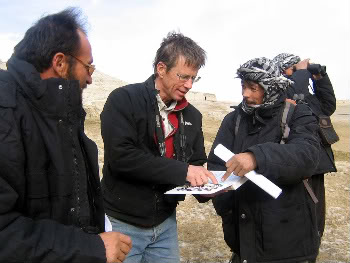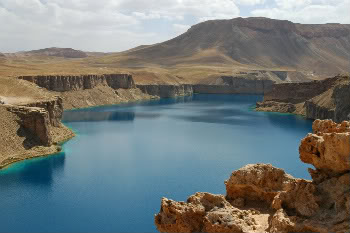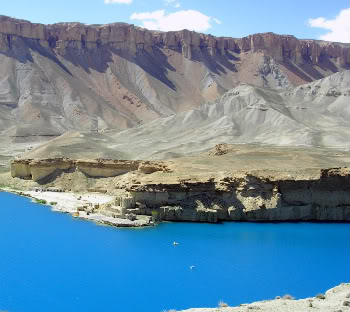|
|
War-wearied Afghanis received uplifting news on Earth Day this year. Their government has announced the creation of the nation’s first national park, Band-e-Amir, protecting a one-of-a-kind landscape encompassing six sky-blue lakes separated by natural dams.
Announced by Afghanistan’s National Environmental Protection Agency (NEPA) at a ceremony in the FAO Building at the Ministry of Agriculture, Irrigation, and Livestock in Kabul this morning, key funding for the park was provided by The United States Agency for International Development (USAID).
 WCS scientist Chris Shank meets with two Afghan park guards. Photo by: Chris Shank from WCS. |
In addition, the Wildlife Conservation Society (WCS) provided support with wildlife surveys, identifying park boundaries, and working with local government and communities. WCS developed the management plan and laws for the park. The park’s creators hope the system set up for Band-e-Amir National Park will be extended to new parks in the future.
“At its core, Band-e-Amir is an Afghan initiative supported by the international community. It is a park created for Afghans, by Afghans, for the new Afghanistan,” said Dr. Steven E. Sanderson, President and CEO of the Wildlife Conservation Society. “Band-e-Amir will be Afghanistan’s first national park and sets the precedent for a future national park system.”
 The largest of the six lakes. Photo by: Alex Dehgan from WCS. |
The park will be protecting one of Afghanistan’s most treasured natural areas. Six lakes resting high in the Hindu Kush Mountains of Central Afghanistan are separated by natural dams made from the rare mineral deposit travertine. Such systems are found in only a few place in the world, most of which are on the UNESCO World Heritage list, a future goal for Afghanistan’s first park. Pollution and human degradation of the fragile travertine dams currently threaten the park.
Unfortunately much of the park’s wildlife has already been lost. But surveys for the new park found ibex; urials, a wild sheep with massive horns; wolves; foxes; and the Afghan snow finch, the only endemic bird in the country. Snow leopards used to dwell in the region but vanished during the 1980s because of hunting.
 Another view of one of the lakes. Photo by: Chris Shank from WCS. |
While Band-e-Amir is not new to travelers it has been little visited since war engulfed the Afghanistan in 1979. After the nation gained some stability following the American-led invasion in 2001, thousands of Afghan tourists returned to Band-e-Amir. As well as natural beauty, the park has religious significance since it is believed the third caliph of Islam visited the region. With the new region’s status and publicity, the country hopes to attract international visitors.
Next on the list, Afghanistan is looking at creating a network of parks, including possible protection for the abundant wildlife in the Pamir Mountains.
Related articles
U.S. military attacks illegal wildlife trade in Afghanistan
(08/22/2007) The U.S. military has teamed with the Bronx Zoo-based Wildlife Conservation Society (WCS) to attack the illegal wildlife trade in Afghanistan, according to a statement from the Department of Defense.
Adventures in conservation: protecting wildlife in Afghanistan:
An interview with Dr. Alex Dehgan, Afghanistan Country Director for the Wildlife Conservation Society
(08/07/2007) Few people associate Afghanistan with wildlife and it would come as a surprise to many that the war-torn, but fledging democracy is home to snow leopards, Persian leopards, five species of canid (wild dog), Marco Polo Sheep, Asiatic Black Bear, Brown Bears, Striped Hyenas, and numerous bird of prey species.
Conservation in War-Torn Afghanistan Begins
(06/26/2006) In a country known more for conflict than conservation, a joint effort by the government of Afghanistan and the Wildlife Conservation Society (WCS) and funded by the United States Agency for International Development (USAID) has been launched to protect the region’s unique wildlife and develop the country’s first official system of protected areas.